
Many have seen the recent video of a South Carolina school officer dragging a black student across the floor. Whereas this and other recent instances of police violence point to racial profiling in law enforcement, the publicity around these cases also diverts attention from an even bigger problem: the violence black Americans inflict on one another.
A year ago on Meet the Press, former New York City Mayor Rudolph Giuliani mentioned a figure from a 2010 Bureau of Justice Statistics report: 93 percent of blacks killed in the U.S. are victimized by other blacks. His aim was to show how media coverage of the August 2014 killing of Michael Brown scapegoated cops who work arduously to fight crime in black neighborhoods. Giuliani's message was that police have been getting a bad rap for embracing anti-crime mandates which have historically received particularly vocal support from the very communities most prone to racial profiling.
There's another significant story contained in this "93 percent" statistic which most of the buzz around Giuliani's comment missed: the stark racial inequality African Americans endure nowadays. That those who commit violent crime are often unemployed, live in substandard housing, and have low educational attainment testifies to the fact that blacks comprise twice the amount of the poor population as they do of the U.S. population as a whole.
It's not a coincidence that poverty runs rampant among a group that was enslaved for over 200 years and endured a racial caste system for another century after emancipation. The massive racial gap in wealth that continues today is a remnant of historic racism, with the average black household holding just 6 percent of the wealth as the average white household. This means a significant percentage of blacks continue to be disadvantaged in their capacity to buy or rent homes in neighborhoods with low crime and high-quality schools.
It's easy to see racism when a white police officer kills an unarmed black citizen. We should feel similar outrage when the perpetrator and victim are both African American. Such violence also reflects the structural inequalities that adversely impact black lives. That there's little reporting about these inequalities at a time when names like Freddie Gray and Tamir Rice frequently capture the headlines fosters the misconception that race plays no role in the epidemic of black-on-black violence. As New Yorker writer Kelefa Sanneh recently wrote, "the outrage over relatively rare police killings should remind us just how much everyday violence--and just how much everyday inequality--we have learned to ignore."